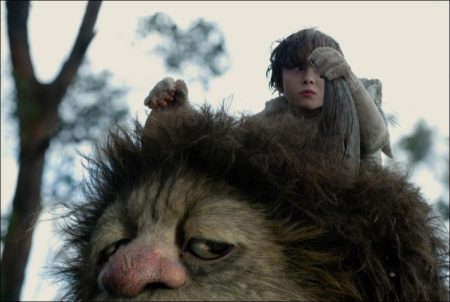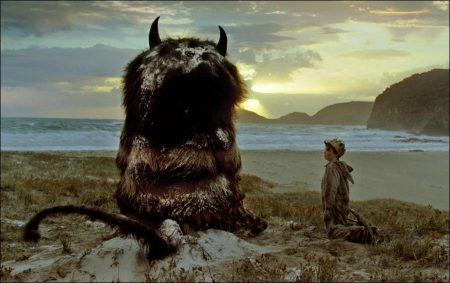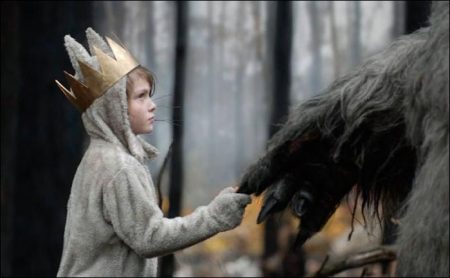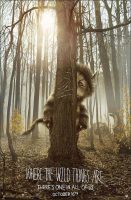Taglines: There’s one in all of us.
Where the Wild Things Are movie storyline. Max, a rambunctious and sensitive boy feels misunderstood at home and escapes to where the Wild Things are. Max lands on an island where he meets mysterious and strange creatures whose emotions are as wild and unpredictable as their actions. The Wild Things desperately long for a leader to guide them, just as Max longs for a kingdom to rule. When Max is crowned king, he promises to create a place where everyone will be happy. Max soon finds, though, that ruling his kingdom is not so easy and his relationships there prove to be more complicated than he originally thought.
Where the Wild Things Are is a 2009 fantasy drama film directed by Spike Jonze. Written by Jonze and Dave Eggers, it is adapted from Maurice Sendak’s 1963 children’s book of the same name. It combines live-action, performers in costumes, animatronics, and computer-generated imagery (CGI). The film stars Max Records and features the voices of James Gandolfini, Paul Dano, Lauren Ambrose, Forest Whitaker, Catherine O’Hara, and Chris Cooper. The film centers on a lonely eight-year-old boy named Max who sails away to an island inhabited by creatures known as the “Wild Things,” who declare Max their king.
The studio decided not to position the film as a children’s movie and spent 70% of the advertising on broad-based and adult-driven promotion. The film was released in North America in both conventional and IMAX theaters on October 16, 2009. Early Friday box office estimates show the film earned about $32.7 million on its opening weekend in theaters. It grossed $77.2 million during its theatrical run in the U.S. and Canada, plus $22.8 million internationally.
Inside All Of Us Is A Wild Thing
“I didn’t set out to make a children’s movie; I set out to make a movie about childhood,” says director Spike Jonze, whose big-screen adaptation of the captivating Maurice Sendak classic Where the Wild Things Are was truly a labor of love. In it, he further explores the themes Sendak introduced and which Jonze believes remain relevant to every generation. “It’s about what it’s like to be eight or nine years old and trying to figure out the world, the people around you, and emotions that are sometimes unpredictable or confusing-which is really the challenge of negotiating relationships all your life,” he says. “It’s no different at that age.”
“Where the Wild Things Are” offers a fresh look-and for many of us, a look back-into the many facets of childhood. It invites audiences of all ages to join in the discovery and challenge and pure feral joy of a young boy’s brave journey to the island of the Wild Things, a special place that’s sure to stir thoughts of the wild things that live in all of us.
“In a way, it’s an action movie starring a nine-year-old. There’s a lot of physical mayhem like dirt clod fights and rampaging in the forest,” says Jonze. Indeed, the island offers up every youngster’s fantasy: the freedom to run and jump and howl, to build and destroy and wrestle and throw things as far as he can… most of all, to do only the things he wants to do, with no one saying he can’t.
Resplendent in his wolf costume, young Max soon becomes King of the Wild Things by proving his superior ferocity over the giant creatures who live there. But it’s an uneasy reign because the Wild Things are just that- wild-and there is always the possibility they might decide to eat him after all, with their great sharp teeth. Being king just might not be as easy as Max imagined.
At the same time, the story follows Max’s first steps toward growing up as he becomes aware of the complex relationships the individual Wild Things have with each other and with him, and how doing everything he wants isn’t always the best choice. Told with unabashed honesty from a child’s point of view, “Where the Wild Things Are” reveals Max’s increasing understanding of his own feelings and the feelings of others. The film began with Jonze’s abiding affection and respect for the book, written and illustrated by Sendak, another strong believer in not talking down to young people.
Published in 1963, it earned a Caldecott Medal and went on to touch millions of readers worldwide, perpetually ranked by Publishers Weekly as one of the 10 all-time best-selling books for children since the 1970s.
Its enduring appeal, notes Jonze, is in how it “taps into genuine feelings that kids have and takes them seriously without pandering. Kids are given so much material that’s not honest, so when they find a story like this it really gets their attention. I remember myself, at that age, being so eager to hear that other kids were going through the same things I was and having similar thoughts.”
Max Records, now twelve, made his film debut as Max in “Where the Wild Things Are” and agrees. “The book reflects what it’s actually like to be a kid. It’s a book that could not only be respected by kids but it really gets to the heart of everything you feel growing up and even beyond that.”
It was that idea of “beyond” that led Jonze to realize what he could contribute to the story. Adapting the slim volume into a feature film gave him the opportunity to take the adventure further, to delve deeper into Max’s world, the unknown terrain of the island and the impetus that brings him there. He could examine more fully the Wild Things themselves, those volatile and endlessly expressive creatures which are “the wild emotions inside of Max and inside all of us.”
From that point, the possibilities were limitless. Jonze selected acclaimed novelist and fellow Wild Things fan Dave Eggers to collaborate with him on the screenplay, though Eggers had never written for film. This did not surprise Vincent Landay, Jonze’s longtime collaborator and a producer on “Where the Wild Things Are,” who offers, “Spike’s instinct about Dave was based on knowing him as a person and knowing he had the right sensibility and the right take on what he wanted out of these characters. Spike likes to put people into situations where they might not have been in before because you often end up with a fresher result.”
Before long, the two met with Sendak in his Connecticut home to go over their plans for the movie. Unquestionably, they wanted to keep it true to the author’s values and intention; otherwise they would not attempt it. Of their initial discussions, Eggers remembers, “We wanted to make a movie that didn’t look down at a kid but got inside him. Most kids in movies are `de-fanged.’ They have no wildness. What we figured out pretty quickly was that we all clearly remembered what it was like to be a boy, to be a little wild and get into trouble. We understood who Max was. We didn’t need to focus-group it or ask a child psychologist about what a child thinks or believes; we knew it in our guts.”
What ensued was an old-fashioned brainstorming process of two first-time screenplay writers locked in a room, hammering out ideas and dialogue together, acting out characters and melding their very different methods. “Dave is a very disciplined writer. If he gets stuck, he puts in a placeholder and keeps going whereas, for me, if it doesn’t feel right I will stay in that place until I find what works. I don’t want to let it go,” Jonze admits, to which Eggers adds, “Spike’s method is the definition of organic. I often saw myself as the facilitator, helping to put his ideas on paper and fill it out.”
“First and foremost I was concerned with who Max was and what was going on in his life,” says Jonze. “I wanted to make a movie that takes kids seriously but Maurice said, `Make sure you don’t just take the heavy side of the kid seriously; take his imagination seriously, his sense of joy.’ We never set any rules about whether it would be for kids or adults. We just went where it took us.”
Serving as a producer on the film, Sendak was fully involved from those early conversations and throughout production. He says, “Spike immediately had his own point of view. I trusted him. I knew he had a vivid sense of what the book was about in his head, which was the same with me when I wrote it.
“He’s given me a renewal of respect for young people,” the author continues, saying that so few people he encounters have Jonze’s “bite,” nor his interest “in history, or the world they came from. They just want to be what they want to be, without the luxury of learning about it. Spike is like a throwback, in that he reminds me of the young people I remember from the 1960s; kind of crazy but in the most wonderful, adventurous way. For me, the 60s was an exuberant and splendid time.”
It was an inspired creative match, attests producer John Carls, who has worked with Sendak for 17 years, since the two formed Wild Things Productions in 1992. “He and Spike are very similar as artists. They’re both bold and innovative thinkers, constantly challenging the status quo; they’re both hard-working perfectionists who pour everything into their work; and they’re both in touch with their childlike selves, which gives them a perspective that connects authentically with children.”
Ultimately, the film was a combination of their stories and recollections. Says Jonze, “Maurice based the book on themes and feelings from his life, his childhood. I was picking up the baton.”
“Spike is an incredibly gifted young man and courageous,” says Sendak. “He didn’t do an homage to the book; he did something that belongs to him, which makes him a real filmmaker and a real artist. I love the movie. It’s original. It has an entire emotional, spiritual, visual life which is as valid as the book. He’s turned it into his `Wild Things’ without giving up mine, in a brilliant, modern, fantastical way which takes nothing from my book but enhances and enriches it. They are two very different works of art and I like them both.”
Capturing The Look, The Feel
As much as Jonze wanted to present Max as a real boy, he sought to give the story’s imaginative elements a realistic execution, explaining, “I wanted to build and shoot the Wild Things so that Max could touch them, lean on them, shove them, hug them. I wanted them to be there so people could feel their breath, their size and their weight in a visceral and immediate way and I couldn’t imagine doing that wholly in a computer or on a soundstage.”
Each story dictates a filmmaking process that best serves it,” Carls observes. “In the case of `Where the Wild Things Are,’ Spike wanted to deliver an adventure that felt real, rather than a dream or a fantasy. Casting an actor to interact with physical creatures on a real location was the best way to accomplish that. He and this talented team of artists brought the Wild Things to life in the way we imagined them when reading the book.”
Producers Tom Hanks and Gary Goetzman, also longtime fans of Sendak’s work, concur. Says Goetzman, “We started developing `Where the Wild Things Are’ twelve years ago with Maurice and John Carls. It actually predated the inception of our production company, Playtone, and was one of the first projects we started working on as a company. We considered animated and CGI versions but it wasn’t until we met Spike Jonze and heard his approach that we felt we’d found a truly visionary director able to flesh out this iconic book into a feature-length film.”
The film is an extraordinary merger of live action, state-of-the-art puppetry and computer animation, putting Max directly into the company of nine-foot-tall monsters in all their fanged, tufted, striped and wide-eyed glory, simultaneously ferocious and endearing.
The beasts were given heart and soul by voice performances from a stellar ensemble cast led by Lauren Ambrose, Chris Cooper, James Gandolfini, Catherine O’Hara and Forest Whitaker, then put through their paces on location by costumed actors who melded body language to the dialogue. Finally, their already expressive faces were digitally enhanced for the range of movement and subtlety their thoughts and actions required.
Says Jonze, “I knew it was going to be a complicated process. It seemed that every choice we made turned out to be the hardest possible way to do it. Building the creatures alone took eight months. But we decided what we wanted it to feel like and worked backwards from there on how to achieve that, and stuck to it.”
Producer Landay, integral to the daily hands-on effort and the master plan, admits, “I’m pretty tenacious. I feel if something’s not happening it’s because we didn’t try hard enough or we didn’t look into enough ways to make it happen. The only way to get through something this massive is to break it down and solve each component, step by step. It’s all a puzzle, and making movies is just a gigantic crossword. Luckily, we’ve built a great team over the years, with a strong vocabulary.”
In addition to Landay, who worked with Jonze on both “Being John Malkovich” and “Adaptation,” Jonze’s creative team on “Where the Wild Things Are” reunited many of his longtime colleagues, including cinematographer Lance Acord, production designer K.K. Barrett, editor Eric Zumbrunnen and costume designer Casey Storm. He also reenlisted the musical talents of former collaborators Karen O and Carter Burwell.
Where the Wild Things Are (2009)
Directed by: Spike Jonze
Starring: Catherine Keener, Benicio Del Toro, Forest Whitaker, Lauren Ambrose, Catherine O’Hara, Michael Berry, James Gandolfini, Steve Mouzakis, Nick Farnell, Madeleine Greaves, Pepita Emmerichs
Screenplay by: Dave Eggers
Production Design by: K.K. Barrett
Cinematography by: Lance Acord
Film Editing by; James Haygood, Eric Zumbrunnen
Costume Design by: Casey Storm
Set Decoration by: Lisa Thompson
Art Direction by: Lucinda Thomson, Jeffrey Thorp
Music by: Carter Burwell, Karen O
MPAA Rating: PG for mild thematic elements, some adventure action and brief language.
Distributed by: Warner Bros. Pictures
Release Date: October 16, 2009
Views: 60






